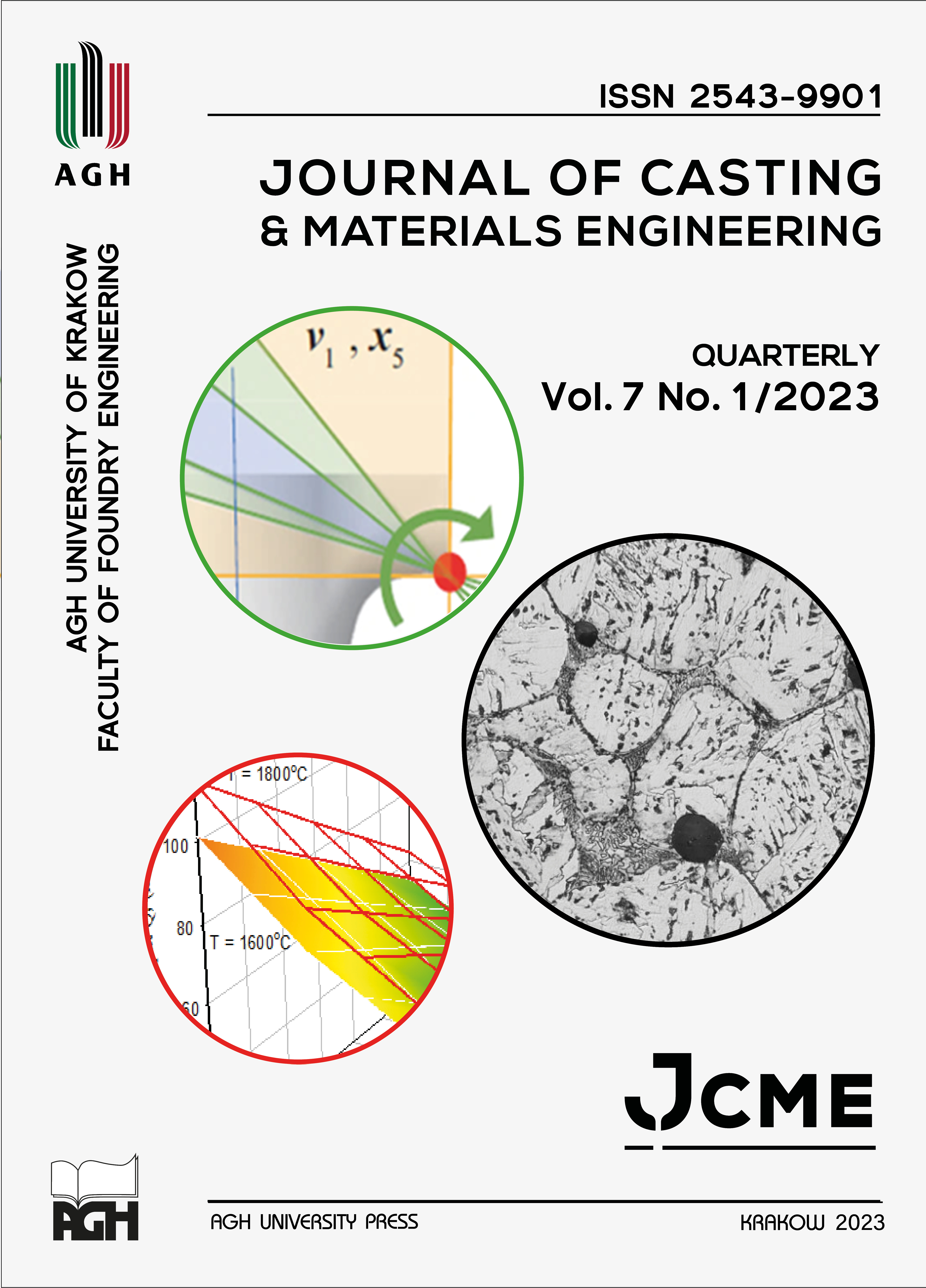Research on New Al-Ag-Mo Alloys Dedicated to Wire Applications in Overhead Power Lines
DOI:
https://doi.org/10.7494/jcme.2023.7.1.9Abstract
The latest research work in the field of electric power systems focuses on the development of new wire materials which will allow the increase of the transmission capacity of power lines currently in use. The reason for this research was the often limited possibilities of continuous and failure-free transmission of electricity. In this paper, the authors present research on a new aluminium-based alloy dedicated for use as a conductive braid in the HTLS cable group. There are many technical solutions for this group of cables on the market, although they are solutions with a number of disadvantages, ranging from their high price, various operational shortcomings, complicated installation techniques, and ending with the risk of monopolistic practices, which is related to the inability to attract several competitive suppliers. The main aim of the research was to develop a new alloy based on aluminium with the addition of silver and molybdenum dedicated for use in special overhead power cables. Experimental research on new materials focused on obtaining the necessary knowledge to produce an overhead wire from these alloys with higher current carrying capacity in relation to the currently used conventional wire materials based on aluminium.
Downloads
References
Zhang C. & Chen R. (2013). Patent No. CN103014462 A. China, The State Intellectual Property Office of People’s Republic of China.
Gaofeng W. (2013). Patent No. CN103021500 A. China, The State Intellectual Property Office of People’s Republic of China.
Central South University (2013). Patent No. CN102965550 A. China, The State Intellectual Property Office of People’s Republic of China.
Daimin Cable Ltd. (2013). Patent No. CN102978491 A. China, The State Intellectual Property Office of People’s Republic of China.
Furukawa Electric Co. Ltd. (2013). Patent No. EP2597169 A1. Munich, Germany, European Patent Office.
Misato K., Yoshihiro N., Taichirou N., Yoshiyuki T. & Yasuyuki O. (2014). Patent No. US 8653374. United States Patent and Trademark Office.
Siripurapu S., Muojewu C., Sekunda J., Baker R., Duer N. & Vo N. (2017). Patent No. WO/2017/066638. Canadian Patent Application.
Siripurapu S., Muojewu C., Sekunda J., Baker R., Duer N. & Vo N. (2019). Patent No. US20170110704 A1. United States Patent Application Publication.
Net. Sci. Ltd. (2020). Patent No. CN110791685 A. China, The State Intellectual Property Office of People’s Republic of China.
Wuhan Cable Ltd. (2020). Patent No. CN110669951 A. China, The State Intellectual Property Office of People’s Republic of China.
Knych T. (2010). Elektroenergetyczne przewody napowietrzne. Teoria – materiały – aplikacje. Kraków: Wydawnictwa AGH.
Uliasz P. (2010). Dobór materiału i opracowanie konstrukcji wysokotemperaturowych przewodów elektroenergetycznych ze stopów AlZr [doctoral dissertation]. AGH University of Science and Technology.
Yaojun M., Feng Z., Xiaolin M., Chunjian X. & Xiaohong H. (2009). Patent No. CSN EN 62004. China, The State Intellectual Property Office of People’s Republic of China.
Koike K. (1966). Patent No. US3278300. United States Patent Office.
Iricibar R., Pampillo C. & Chia U. (1980). Metallurgical aspects of aluminium alloys for electrical applications. In: Embury D.E., Pampillo C.A. & Biloni H., Aluminium Transformation Technology and Applications: Proceedings of the International Symposium at Puerto Madryn, Chubut, Argentine, August 21–25, 1978, 241–303.
Kenji M. & Toshiya I. (2000). Patent No. EP0787811 B1. European Patent Application.
Matsuda Y., Yokota M. & Okumura T. (1972). Traces of Yttrium in ACSR aluminium boosts transmission efficiency 50%. Wire Journal, #P02831. https://portal.wirenet.org/[accessed: 28.10.2022].
Knych T., Mamala A., Grzebinoga J., Kwaśniewski P., Ściężor W., Kiesiewicz G., Gniełczyk M. & Kowal R. (2015). Badania wpływu dodatku chromu do aluminium na własności mechaniczne i elektryczne drutów AlCr. Hutnik. Wiadomości Hutnicze, 1(82), 59–63. Doi: https://doi.org/10.15199/24.2015.1.12.
Mamala A., Kowal R., Kwaśniewski P., Knych T., Ściężor W., Kiesiewicz G., Gniełczyk M. & Grzebinoga J. (2015). Badania wpływu dodatku wapnia do aluminium na własności mechaniczne i elektryczne stopów Al-Ca. Hutnik. Wiadomości Hutnicze, 82(1), 81–84. Doi: https://doi.org/10.15199/24.2015.1.17.
Grzebinoga J., Mamala A., Knych T., Kwaśniewski P., Ściężor W., Kiesiewicz G., Kawecki A., Sieja-Smaga E. & Jurkiewicz B. (2016). New aluminium base materials for use on electrical purposes. Key Engineering Materials, 682, 61–68. Doi: https://doi.org/10.4028/www.scientific.net/KEM.682.61.
Mamala A., Grzebinoga J., Kowal R., Ściężor W., Jabłoński M. & Gniełczyk M. (2017). Własności reologiczne nowych stopów na bazie aluminium dedykowanych do zastosowań na cele elektryczne. Rudy i Metale Nieżelazne Recykling, 7(62). Doi: https://doi.org/10.15199/67.2017.7.2.
Snopiński P., Matus K., Taticek F. & Rusz S. (2022). Overcoming the strength-ductility trade-off in additively manufactured AlSi10Mg alloy by ECAP processing. Journal of Alloys and Compounds, 918, 165817. Doi: https://doi.org/10.1016/j.jallcom.2022.165817.
Maziarz W., Greger M., Długosz P., Dutkiewicz J., Wójcik A., Rogal Ł., Stan-Głowińska K., Hilser O., Pasternak M., Cizek L. & Rusz S. (2022). Effect of severe plastic deformation process on microstructure and mechanical properties of AlSi/SiC composite. Journal of Materials Research and Technology, 17, 948–960. Doi: https://doi.org/10.1016/j.jmrt.2022.01.023.
Kawecki A., Sieja-Smaga E., Knych T., Mamala A., Kwaśniewski P., Kiesiewicz G. & Ichas K. (2015). Badania wpływu parametrów obróbki cieplnej i przeróbki plastycznej na optymalizację własności elektrycznych drutów ze stopu CuAg5. Hutnik. Wiadomości Hutnicze, 82(1), 51–54. Doi: https://doi.org/10.15199/24.2015.1.10.
Kawecki A., Knych T., Sieja-Smaga E., Mamala A., Kwaśniewski P., Kiesiewicz G. & Pacewicz A. (2013). Badania wpływu ciągnienia i obróbki cieplnej na własności wytrzymałościowe i elektryczne drutów ze stopów CuAg5 i CuAg15 z linii ciągłego topienia i odlewania. Hutnik, Wiadomości Hutnicze, 80(1), 47–50.
Sieja-Smaga E., Kawecki A., Knych T., Kiesiewicz G. & Kwaśniewski P. (2013). Analiza zmian odporności cieplnej stopów Cu-Ag z przeznaczeniem na wyroby branży elektroenergetycznej. XLI Szkoła Inżynierii Materiałowej: 24–27 września. Kraków – Krynica. Wydawnictwo Naukowe AKAPIT, 434–438.
Downloads
Published
Issue
Section
License
Copyright (c) 2023 Justyna Grzebinoga, Andrzej Mamala, Wojciech Ściężor, Radosław Kowal

This work is licensed under a Creative Commons Attribution 4.0 International License.
How to Cite
Accepted 2023-03-29
Published 2023-03-31


